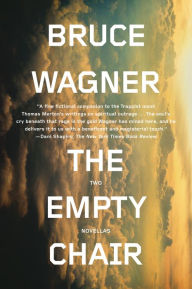Bruce Wagner is the author of Dead Stars, Memorial, The Chrysanthemum Palace (a PEN/Faulkner fiction award finalist), Still Holding, I’ll Let You Go, I’m Losing You, and Force Majeure. He lives in Los Angeles.
The Empty Chair: Two Novellas
by Bruce Wagner
eBook
-
ISBN-13:
9781101630747
- Publisher: Penguin Publishing Group
- Publication date: 12/17/2013
- Sold by: Penguin Group
- Format: eBook
- Pages: 304
- File size: 889 KB
- Age Range: 18 Years
What People are Saying About This
Available on NOOK devices and apps
Want a NOOK? Explore Now
Composed of two companion novellas, The Empty Chair is a profound, heart-wrenching piece of spiritual storytelling from Bruce Wagner, the internationally acclaimed author of such novels as Dead Stars, I’m Losing You and Force Majeure. In First Guru, a fictional Wagner narrates the tale of a Buddhist living in Big Sur, who achieves enlightenment in the horrific aftermath of his child’s suicide. In Second Guru, Queenie, an aging wild child, returns to India to complete the spiritual journey of her youth. Told in ravaged, sensuous detail to the author-narrator by two strangers on opposite sides of the country, years apart from each other, both stories illuminate the random, chaotic nature of human suffering and the miraculous strength of the human spirit. A deeply affecting and meditative reading experience, The Empty Chair is an exquisitely rendered, thought-provoking, and humbling new work.
Customers Who Bought This Item Also Bought
-
- McTeague: A Story of San…
- by Frank NorrisClay Motley
-
- I'm Losing You: A Novel
- by Bruce Wagner
-
- Snow White
- by Donald Barthelme
-
- Me and You
- by Niccolò AmmanitiKylee Doust
-
- A Blessed Child
- by Linn Ullmann
-
- Easy in the Islands
- by Bob Shacochis
-
- Flimsy Little Plastic Miracles…
- by Ron Currie
-
- My Old Man
- by Amy Sohn
-
- The Painter of Signs
- by R. K. NarayanMonica Ali
-
- Sway: A Novel
- by Zachary Lazar
-
- East Side Story: A Novel
- by Louis Auchincloss
-
- Another World: A Novel
- by Pat Barker
Recently Viewed
These two novellas are linked by spiritual questing, by the relative unorthodoxy of the characters, and by a chair, which plays a key role in both the events of the stories and the narrator's understanding. Set as a series of interviews by the author's fictional persona, "First Guru" concerns a closeted gay Buddhist living in Big Sur with his Buddhist teacher wife and the aftermath of their 12-year-old son's suicide—he hanged himself from a chair. "Second Guru" is about a wealthy New York wild child who reunites after 30 years with the lover of her youth, the shadowy spiritual gangster Kura. Returning with him to India, where they once ventured in search of the "Great Guru," the former lovers now seek his enigmatic successor, an American who abdicated the "guru's chair" and disappeared into seclusion. VERDICT Wagner (Dead Stars) presents the search for the spiritual as a messy, unpredictable journey where neither the teachers nor the students may be exactly as expected. A powerful, agonizing, and yet meditative work about how suffering and somehow resilient human beings struggle to make sense of the mystery of existence. [See Prepub Alert, 6/10/13.]—Lawrence Rungren, Merrimack Valley Lib. Consortium, Andover, MA
In this new collection of two novellas by the author of Dead Stars, a fictionalized Wagner sits down with two disparate characters who have undergone traumatic spiritual journeys, interviewing them over the course of a few days. In “First Guru,” a gay man explains his love of Jack Kerouac, and narrates the story of his life, from being molested in a Catholic church to marrying a woman and having a child with her, to finally ending up where Wagner finds him, sleeping in and operating his book-van lending library. “Second Guru” concerns a woman, Queenie, on a trip to India, as she reconnects with her old flame, Kura, after battling with depression and the aftermath of an abusive relationship, in search of his former spiritual guide. The collection is aptly named, as the metaphor of the empty chair comes to mean radically different things for each of the protagonists and their journeys toward and away from Buddhism. Throughout the interviews, Wagner interjects descriptions of his subjects, lending believability to the format, and the dialogue is spot-on—especially when Queenie ruminates on her fantasies of self-obliteration. Ultimately a quiet, brooding collection, Wagner’s book deftly illustrates how the quest for spirituality and self-realization underscore one’s understanding of the purpose of life. (Dec.)
—Michiko Kakutani, The New York Times
“Wagner’s book deftly illustrates how the quest for spirituality and self-realization underscore one’s understanding of the purpose of life.”
—Publisher’s Weekly
“While Wagner’s trademark scathing satirical skills are in full force thanks to his sprightly word play and jaundiced observations, his purposeful exploration of the nature and importance of storytelling takes him in a subtly nuanced new direction.”—Booklist
“Lushly embroidered with allusions to the Beat Generation…Wagner meditates on our fundamental cravings for connections—both human and divine—and meanings—both personal and cosmic—with wit, compassion and a sharp eye for the lies we tell ourselves.”—Kirkus, STARRED review
















